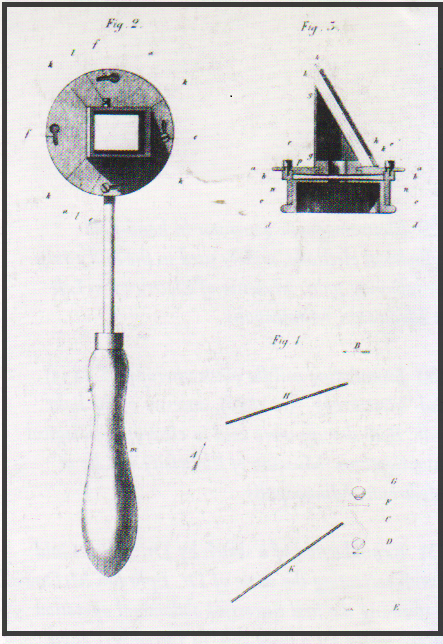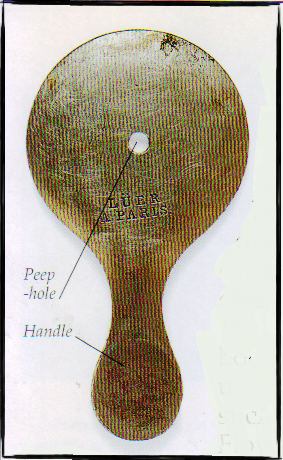-
Paper Information
- Paper Submission
-
Journal Information
- About This Journal
- Editorial Board
- Current Issue
- Archive
- Author Guidelines
- Contact Us
Research in Ophthalmology
2014; 3(1): 1-4
doi:10.5923/j.ophthal.20140301.01
Helmholtz Who Revolutionized Ophtalmology
Nāsir pūyān (Nasser Pouyan)
Tehran, Iran
Correspondence to: Nāsir pūyān (Nasser Pouyan), Tehran, Iran.
| Email: |  |
Copyright © 2014 Scientific & Academic Publishing. All Rights Reserved.
Helmholtz (1821-1894), German physician, surgeon and scientist who studied medicine in Berlin, wrote his thesis on ganglia. He studied biophysics of nerves, and muscle contraction. Helmholtz developed a method of obtaining electromyogram of the muscles in 1851, and carried out pioneering work on muscle energy. He invented on ophtalmoscope aiding work on vision (1851), and described the mechanism of accommodation of the eye and perception of color. His name occurs frequently in physics associated with Helmholtz resonators, Helmholtz free energy, and Helmholtz coils. He published a far reaching importance to physics and physiology “The Conservation of Forces”.
Keywords: Helmholtz, Ophthalmology, Acoustic, Energy tangent galvanometer
Cite this paper: Nāsir pūyān (Nasser Pouyan), Helmholtz Who Revolutionized Ophtalmology, Research in Ophthalmology, Vol. 3 No. 1, 2014, pp. 1-4. doi: 10.5923/j.ophthal.20140301.01.
- Hermann Ludwig Ferdinand von Helmholtz one of the great genius of medicine, born (August 31, 1821) in Potsdam, Kingdom of Prussia. He studied medicine at the Friedrich- Wilhelm Institute of Medicine and Surgery in Berlin. His thesis was on the nerve cells in ganglia. Helmholtz was professor of physiology in turn at the universities of Königsberg, Bonn, and Heidelberg. On July 23, 1847, Helmholtz presented his treatise of far-reaching importance to physics and physiology, “Uber die Erhaltung der Kraft” (“One the Conservation of Force”), to the Physical Society of Berlin. This treatise death with the conservation of energy, a subject which he deeply clarified [1]. Helmholtz’s great work, “Handbuch der Physiologischen Optik” (“Handbook of physiological Optics” or “Treatise on Physiological Optics”), (1856-1866) provided empirical theories on depth perception, color vision, and motion perception. It became the fundamental reference work, during the second half of the 19th century. In the third and final volume, published in 1867, he described the importance of unconscious inferences for perception. “Handbuch der Physiologischen Optik” was first translated into English under the editorship of James P.C. Southall on behalf of the Optical Society of America in 1924-1925.Helmholtz became professor of physics in the University of Berlin in 1870. He began serving concurrently as director of the “German Bureau of Standards.” He studied the biophysics of nerves, muscle contraction, optics, and color theory [2], but his accomplishments include the invention of the ophtalmoscope and ophtalmometer. He improved on Young’s1 theory of color vision, now referred to as Thomas “Young-Helmholtz theory.2” His name occurs frequently in physics associated with Helmholtz resonators, Helmholtz free energy, and Helmholtz coils [3]. As one of the gifted students of Johannes Peter Müller3 (1801-1858), German pioneering physiologist, he became one of the trendsetters in scientific and medical research [4].
 | The ophthalmoscope devised by Hermann von Helmholtz that made the inner eye visible to an examining diagnostician |
 | Hermann Ludwig Ferdinand Helmholtz, who made the inner eye visible to ophthalmologists |
 | Herman von Helmholtz is examining the inner eye of a patient |
1. The Highlights
 He is responsible for a great number of acoustic instruments, the most fundamental probably being the resonator theory of hearing, making possible the analysis and synthesis of complex sound6.
He is responsible for a great number of acoustic instruments, the most fundamental probably being the resonator theory of hearing, making possible the analysis and synthesis of complex sound6. Pioneer work on energy was done by him arou 1850.
Pioneer work on energy was done by him arou 1850. He improved tangent galvanometer by adding two co-axial cables. This was followed in 1840 by an electrodynamometer invented by another German physicist, Wilhelm Eduard Weber7 (1804-1891) [7].
He improved tangent galvanometer by adding two co-axial cables. This was followed in 1840 by an electrodynamometer invented by another German physicist, Wilhelm Eduard Weber7 (1804-1891) [7]. He invented the ophtalmoscope to facilitate his research on the physics of vision.
He invented the ophtalmoscope to facilitate his research on the physics of vision. Helmholtz measured the speed of conduction along a nerve fibre, and reported transmissions speeds in the range of 24.6- 38.4 meter persecond [8].
Helmholtz measured the speed of conduction along a nerve fibre, and reported transmissions speeds in the range of 24.6- 38.4 meter persecond [8]. He developed a law of the conservation of energy- that energy could neither be created nor destroyed- which delivered a body blow to the theory of vitalism.
He developed a law of the conservation of energy- that energy could neither be created nor destroyed- which delivered a body blow to the theory of vitalism. In 1880, he theorized that the time difference corresponded to the nerve conduction time between the toe and thigh [9].
In 1880, he theorized that the time difference corresponded to the nerve conduction time between the toe and thigh [9]. He was conferred with Honoray Membership of Institution of Engineers and Shipbuilder in Scotland (1884).
He was conferred with Honoray Membership of Institution of Engineers and Shipbuilder in Scotland (1884). As a philosopher, Helmholtz is known for his philosophy of science, ideas on the relation between the laws of perception and the laws of nature, the science of aesthetics, and ideas on the civilizing power of science.
As a philosopher, Helmholtz is known for his philosophy of science, ideas on the relation between the laws of perception and the laws of nature, the science of aesthetics, and ideas on the civilizing power of science. The largest German association, is named after him.
The largest German association, is named after him. He died at Charlottenburg, German Empire in September 8, 1894 at the age of 73.
He died at Charlottenburg, German Empire in September 8, 1894 at the age of 73. | The later version ophthalmoscope acts as a mirror to reflect light into the eye, with a central peep- hole for viewing. |
 | Ophthalmoscope |
2. Conclusions and Impact
- As the very old beliefs about the invisible humours faded, physicians came to this perception that diseases were caused by malformation and malfunction of the organs of the body. Therefore they invented various techniques and devices for clinical diagnosis- examining the patient to identify the ailment. In about 1850, in Germany, Helmholtz made his greatest impact on medicine, specially in ophthalmology through quantative determination in the physiology of sight, sound and nerve impulse. Intent on trying to look inside the eye of living person, he invented ophtalmoscope which shone light into the pupils and enabled the doctors to see the reflected image of the retina, and the invisible blood vessels and nerves of the eye to be seen easily. From then on, abnormalities in the eye were open to the diagnostic gaze of the physician. He also explained the mechanism of accommodation of the eye and perception of color and sound.In a nutshell, his everlasting accomplishments include ophtalmoscope and ophtalmometer. From then on, abnormalities in the eye were open to the diagnostic gaze of the doctor.
Notes
- 1. Ophtalmoscope: An instrument for inspecting the interior of the eye by light reflected from amirror. 2. Thomas Young (1773-1829), outstanding British physician and polymath, founder of physiological optics, who wrote “On the Mechanism of the Eye,” described astigmatism and accommodation, color vision and color blindness. He also developed the ware theory of light. 3. Four promising Young physiologist associated with Müller- Helmholtz, Du Bois- Reymond (1818-1896), German physiologist, Karl Fw Ludwig (1816-1895), pioneer German physiologist, and Ernst Bruke- in 1847 published a manifesto proclaiming that physioly’s goal was to explain all vital phenomena in terms of laws.4. Helmholtz showed that different combinations of resonator could mimic vowel sounds: Alexander Graham Bell (1847-1922), in particular was interested in this but, not being able to read German, misconstrued Helmholtz’s diagrams as meaning that Helmholtz had transmitted multiple frequencies by wire- Which would allow multiplexing of telegraph signals- whereas, in reality, electrical power was used only to keep the resonators in motion. Bell failed to reproduce what he thought Helmholtz had done but later said that, had he been able to read German, he would not have gone on to invent the telephone on the harmonic telegraph principle. 5. The first English edition was from the 1870 third German edition; Ellis’s second English edition from the 1877 fourth German edition was published in 1885; the 1895 and 1912 third and fourth English editions were reprints of the second. 6. Heinrich Rudolf Hertz (1857-1894), German physicist and discover of Hertzian waves, the short- length radio waves essential to modern wireless communication.7. Weber’s instrument was further developed by William Thomas, Lord Kelvin (1824-1907) and James Prescot Joule (1818-1889), in 1883. An improved form of the galvanometer was built in 1880 by Jacques Arsene d’Arsonval (1851-1940) physicist, biologist and physician, and it was named after him. Riverain, Jean. Dictionnaire des Médecins Celebres. P.10.
 Abstract
Abstract Reference
Reference Full-Text PDF
Full-Text PDF Full-text HTML
Full-text HTML